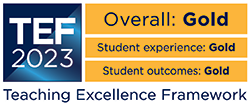Teesside is one of the best for linking widening participation to success and achievement
The University of Teesside is one of the top performing universities in England when it comes to widening access to students from state schools and less well-off neighbourhoods, figures out today (11 Dec) show.
This is the fifth year of the Higher Education Funding Council for England (HEFCE) Performance Indicators - and once again Teesside is among the leaders for attracting a wider social mix of students to its courses.
Professor Graham Henderson, Vice-Chancellor of the University of Teesside, welcomed the news today (11 Dec), saying: “The figures show that we are fulfilling our commitment to widening participation and encouraging more students from under-represented groups into higher education. This is central to our mission as the Opportunity University and supports the Government’s aim of increasing the number and social mix of young people studying at university.”
The Performance Indicators were introduced five years ago by HEFCE to monitor the make-up of the higher education student population. Benchmarks are set for each university to aim for in a number of categories.
The University of Teesside either met or exceeded its target benchmarks in nearly every category and is now joint number one in England for attracting young full-time first degree entrants from state schools.
The percentage of young degree entrants coming from working class backgrounds was 38% (compared with a benchmark of 33%) and from low participation neighbourhoods - up 2% to 24% (benchmark of 16%). The percentage of mature full-time entrants across all undergraduate courses was 36%, with 26% having no previous experience of higher education (benchmark 17%). This percentage of full-time disabled students at Teesside rose slightly to 2.6% (benchmark 2.1%).
Most encouragingly, the figure for non-continuation following the first year on degree courses has improved by 2% to 9% and beat the benchmark set (10%). There was no figure last year for projected completion, but this year the percentage of degree students completing their courses was 72% - better than the benchmark of 71%.
The percentage of graduates in employment or further study also improved, up 1% to 92% and only 1% behind the national university average.
“The figures are some of the best results for the University of Teesside since the Performance Indicators were first introduced five years ago and we are delighted with the results,” said Professor Henderson.
 International partnership signed with prestigious American
...
International partnership signed with prestigious American
... Teesside University academics join prestigious network of
...
Teesside University academics join prestigious network of
... Curatorial studies culminating with international art
...
Curatorial studies culminating with international art
...